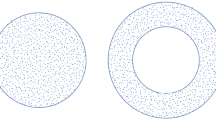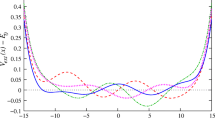Abstract
Collective-density variables have proved to be a useful tool in the prediction and manipulation of how spatial patterns form in the classical many-body problem. Previous work has employed properties of collective-density variables along with a robust numerical optimization technique to find the classical ground states of many-particle systems subject to radial pair potentials in one, two and three dimensions. That work led to the identification of ordered and disordered classical ground states. In this paper, we extend these collective-coordinate studies by investigating the ground states of directional pair potentials in two dimensions. Our study focuses on directional potentials whose Fourier representations are non-zero on compact sets that are symmetric with respect to the origin and zero everywhere else. We choose to focus on one representative set that has exotic ground-state properties: two circles whose centers are separated by some fixed distance. We obtain ground states for this “two-circle” potential that display large void regions in the disordered regime. As more degrees of freedom are constrained the ground states exhibit a collapse of dimensionality characterized by the emergence of filamentary structures and linear chains. This collapse of dimensionality has not been observed before in related studies.










Similar content being viewed by others
References
Feynman, R.P.: Statistical Mechanics. Benjamin, Reading (1972)
Yevick, G.J., Percus, J.K.: New approach to the many-body problem. Phys. Rev. 101(3), 1186 (1956)
Percus, J.K., Yevick, G.J.: Analysis of classical statistical mechanics by means of collective coordinates. Phys. Rev. 110, 1 (1958)
Fan, Y., Percus, J.K., Stillinger, D.K., Stillinger, F.H.: Constraints on collective density variables: one dimension. Phys. Rev. A 44(4), 2394 (1991)
Uche, O.U., Stillinger, F.H., Torquato, S.: Constraints on collective density variables: two dimensions. Phys. Rev. E 70, 046122 (2004)
Sütő, A.: Crystalline ground states for classical particles. Phys. Rev. Lett. 95, 265501 (2005)
Sütő, A.: From bcc to fcc: interplay between oscillating long-range and repulsive short-range forces. Phys. Rev. B 74, 104117 (2006)
Uche, O.U., Torquato, S., Stillinger, F.H.: Collective coordinate control of density distributions. Phys. Rev. E 74, 031104 (2006)
Torquato, S., Stillinger, F.H.: New duality relations for classical ground states. Phys. Rev. Lett. 100, 020602 (2008)
Batten, R.D., Stillinger, F.H., Torquato, S.: Classical disordered ground states: super-ideal gases and stealth and equi-luminous materials. J. Appl. Phys. 104, 033504 (2008)
Zachary, C.E., Torquato, S.: Anomalous local coordination, density fluctuations, and void statistics in disordered hyperuniform many-particle ground states. Phys. Rev. E 83, 051133 (2011)
Torquato, S., Zachary, C.E., Stillinger, F.H.: Duality relations for the classical ground states of soft-matter systems. Soft Matter 7, 3780 (2011)
Batten, R.D., Stillinger, F.H., Torquato, S.: Inherent structures for soft long-range interactions in two-dimensional many-particle systems. J. Chem. Phys. 135, 054104 (2011)
Likos, C.N.: Going to ground. Nature 440, 7083 (2006)
Zachary, C.E., Stillinger, F.H., Torquato, S.: Gaussian core model phase diagram and pair correlations in high Euclidean dimensions. J. Chem. Phys. 128, 224505 (2008)
Flory, P.J., Krigbaum, W.R.: Statistical mechanics of dilute polymer solutions. II. J. Chem. Phys. 18, 1086 (1950)
Venables, J.: Introduction to Surface and Thin Film Processes. Cambridge University Press, Cambridge (2000)
Florescu, M., Torquato, S., Steinhardt, P.J.: Designer disordered materials with large, complete photonic band gaps. Proc. Natl. Acad. Sci. USA 106, 49 (2009)
Giacometti, A., Lado, F., Largo, J., Pastore, G., Sciortino, F.: Effects of patch size and number within a simple model of patchy colloids. J. Chem. Phys. 132, 174110 (2010)
Bianchi, E., Blaak, R., Likos, C.: Patchy colloids: state of the art and perspectives. PCCP, Phys. Chem. Chem. Phys. 13, 6397–6410 (2011)
Kaufman, L.: A reduced storage quasi-Newton trust region approach to function optimization. SIAM J. Optim. 10, 56 (1999)
Torquato, S., Stillinger, F.H.: Local density fluctuations, hyperuniform systems, and order metrics. Phys. Rev. E 68, 041113 (2003)
Torquato, S., Scardicchio, A., Zachary, C.E.: Point processes in arbitrary dimension from fermionic gases, random matrix theory, and number theory. J. Stat. Mech. Theory Exp. P11019 (2008)
Theil, F.: A proof of crystallization in two dimensions. Commun. Math. Phys. 262, 209 (2006)
Stein, E.M., Shakarchi, R.: Fourier Analysis: An Introduction. Princeton University Press, Princeton (2003)
van de Weygaert, R.: Voids and the Geometry of Large Scale Structure. University of Leiden, Leiden (1991)
Ruelle, D.: Statistical Mechanics: Rigorous Results. World Scientific, London (1999)
Torquato, S.: Inverse optimization techniques for targeted self-asssembly. Soft Matter 5, 1157 (2009)
Bracewell, R.N., Chang, K.-Y., Jha, A.K., Wang, Y.-H.: Affine theorem for two-dimensional Fourier transform. Electron. Lett. 29, 3 (1993)
Acknowledgements
We are pleased to offer this contribution to honor M. Fisher, J. Percus, and B. Widom whose own remarkable contributions have vividly demonstrated the originality intrinsic to statistical mechanics. This work was supported by the Office of Basic Energy Sciences, U.S. Department of Energy, under Grant No. DE-FG02-04-ER46108.
Author information
Authors and Affiliations
Corresponding author
Appendix: Affine Theorem and the Ellipse Potential
Appendix: Affine Theorem and the Ellipse Potential
We derive a simple relation transform describing how the Fourier transform of a function in d-dimensional Euclidean space ℝd behaves under invertible affine transformations. We also present selected results for the ellipse potential described in Sect. 3. The ellipse potential is described by the dimensionless aspect ratio, b/a, where b is the length of the minor axis and a is the length of the major axis of the potential in k-space. We go on to show that the ellipse potential is related to the previously studied circle potential by a simple affine transformation, which allows for a simple analysis of the ground state patterns.
1.1 A.1 Affine Theorem for the Fourier Transform
We derive a simple relation describing how the Fourier transform behaves under invertible affine transformations, generalizing a result in two-dimensions to arbitrary dimension [29]. Given a square-integrable function f(r) in d-dimensional Euclidean space, we can define its Fourier transform as:
The inverse Fourier transform is then naturally defined to be:
Let f(r) be a function, f:ℝd→ℝ with a known Fourier transform \(\mathcal{F}[f(\mathbf{r})] = \hat {f}(\mathbf{k})\). Let us apply an invertible linear transformation, A, to r∈ℝd, and denote the inverse by A −1. In order to be completely general, we also apply a translation denoted by the addition of a vector b. We now have:

where we have switched to linear algebra notation for ease and clarity of presentation. Let r′≡A r. In transforming the equation into the new coordinate system, we gain a factor \(\frac {1}{\det(A)}\) from the Jacobian,

Let k′≡(k T A −1)T=(A −1)T k,

where the second step follows from the Fourier shift property [25]. To the best of our knowledge, this result is the first of its kind. It is consistent with the previously mentioned two-dimensional result, as well as the standard results corresponding to multiplication by a constant factor and rotations [25].
Since our simulations are carried out in two dimensions, we will explicate the details of the previous result in this setting. For some invertible affine transformation in two dimensions:

where A is a linear transformation given by the invertible matrix:

and r o is a translation vector:

the Fourier transform of f(A r) is:
where \(\hat{f}(\mathbf{k})\) is the Fourier transform of f(r), A′ is a linear transformation defined by the matrix:
and Δ=det(A)=ad−bc.
In the case of the ellipse potential, the region on which C(k) is constrained can be expressed as a circular exclusion region to which we have applied invertible affine transformations. Since the ground-state properties of the circular exclusion region are well known (in light of previous studies), we can use this information, combined with this affine relation to draw conclusions about the ground-state properties of the ellipse potential. We emphasize that the affine transformation is not applied to the particles themselves and therefore does not allow for the particles to rotate.
1.2 A.2 Results
1.2.1 A.2.1 Disordered Ground States
Ground state configurations were generated over a range of aspect ratios for the ellipse potential at a fixed χ value. Comparing the pair correlation function of the ground states of a potential of given aspect ratio to that of the isotropic circle potential, it is apparent that the approximate affine relation derived in the previous section holds. In addition, if χ is increased to values near but still below 0.5, the particles develop what resemble hard cores and we see the emergence of perfect nematic order (which is by construction).
1.2.2 A.2.2 Crystalline Ground States
One might hypothesize that the crystalline ground states would obey the same affine relationship that the potential exactly obeys and the pair statistics approximately obey, i.e., that the absolute ground state would be an appropriately transformed triangular lattice. However, this is not the case. As can be visually ascertained from Fig. 11, applying the inverse squeeze transformation does not recover the triangular lattice. In order to confirm this, a perturbed transformed lattice configuration was used as an initial particle configuration for simulations using the ellipse potential. Not only did the trials not find the desired lattice to be the ground state, but no true ground state was reached when these initial conditions were used. However, it should be noted that 418 particles cannot be used to created a nearly undeformed, affine transformed triangular lattice in a square box (as is possible with the untransformed triangular lattice), which may have influenced the convergence of the procedure.
Rights and permissions
About this article
Cite this article
Martis, S., Marcotte, É., Stillinger, F.H. et al. Exotic Ground States of Directional Pair Potentials via Collective-Density Variables. J Stat Phys 150, 414–431 (2013). https://doi.org/10.1007/s10955-012-0619-2
Received:
Accepted:
Published:
Issue Date:
DOI: https://doi.org/10.1007/s10955-012-0619-2





